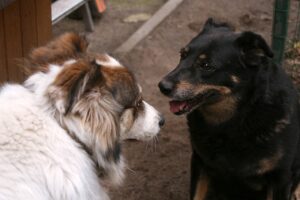Having a New Pet Meet Your Disabled Dog
Pet owners often have a deep love for their pets, and are open to having even more. However, there are right ways and wrong ways to introducing a new pet to a disabled dog.
Dogs (and humans for that matter) often want a predictable home environment because it makes them feel safe and confident. Anything that disrupts the status quo is always problematic, and that includes introducing another pet into his or her world. This is especially true for homeowners with disabled pets from a practical as well as emotional point of view because disabled pets require a lot of care and attention. However, introducing a new member of the household to a disabled dog or other pet is not all that complicated.
Change nothing
The key to introducing a new pet to any household where there are other pets is to keep the environment as close to normal as possible. As a pet owner, you will have to make big changes to your routine, but should strive to keep the setup the same as before the big event. For example, a new pet might bring with it a flurry of new things such as toys and beds, but you should place them outside your current pet’s territory, so to speak.
Letting your current pets carry on as usual with their established accoutrements (barriers, beds, toys, play area) will be a big comfort to them, and less likely to provoke any aggression towards the new member of the household. If some tension does come up in the first few days, keep them apart until the current pets get used to the new kid.
Make the right choices
The reason you might be thinking of bringing in another pet is to give your current pet a companion. If this is the case, you need to ensure that the new guy will be compatible to the current inmates. For example, if you have a dog who likes to spend a majority of his or her time just chilling, a hyperactive companion might be too much too handle.
You also want to choose the breed of a companion dog that will not clash with the breed of your current pet. In most cases, you want a second dog to be docile and friendly to other dogs. You can observe this when choosing to adopt a pet while they are in the company of other dogs.
Alternatively, if you want to rescue a disabled dog, you need to consider if your furry friend at home is likely to be too much for the rescue dog, or if it will drastically change your own routine. Remember that a disabled dog requires a lot more attention, and that can have a detrimental effect on your current pet.
Aim for neutral ground
A good way to introduce two pets to each other is to do it on neutral ground, preferably outdoors. Make sure you have them on a leash so you can step in when necessary. It is also a good idea to have some treats available to encourage good behavior and create a positive experience for all parties.
If you have a deaf or blind dog, they can still smell the other guy, so this can make them feel vulnerable. Keeping the new guy in its line of visions or attaching bells to the leash can make your deaf or blind dog feel less vulnerable.
On the other hand, if you have a disabled dog in a wheelchair, the new guy might feel nervous about it. Allow the new guy to explore the wheelchair and give them treats when it does to reassure it that it is safe.
The most important factor here is still you. Dogs are quick to sense how you are feeling, so make sure you are exuding positive and happy energy when doing the introductions.
Relax
Once you have made the introductions, it is important to let the new housemates get to know each other without too much supervision. Pets can keep each other company and happy while you’re busy, and this is important, especially for disabled pets. Do keep an unobtrusive eye on them for signs of aggression for the first few days, but keep it on the down low. In most cases, they will bond for life if they get past the getting-to-know-you phase unscathed.
Conclusion
The truth is most of your concerns are probably not shared by your dogs. As long as you do your homework and keep your environment an accepting one, your dogs should interact quite happily after a few days. Just make sure that you continue to provide your disabled dog with the same care and attention as before to avoid any problems down the line.
